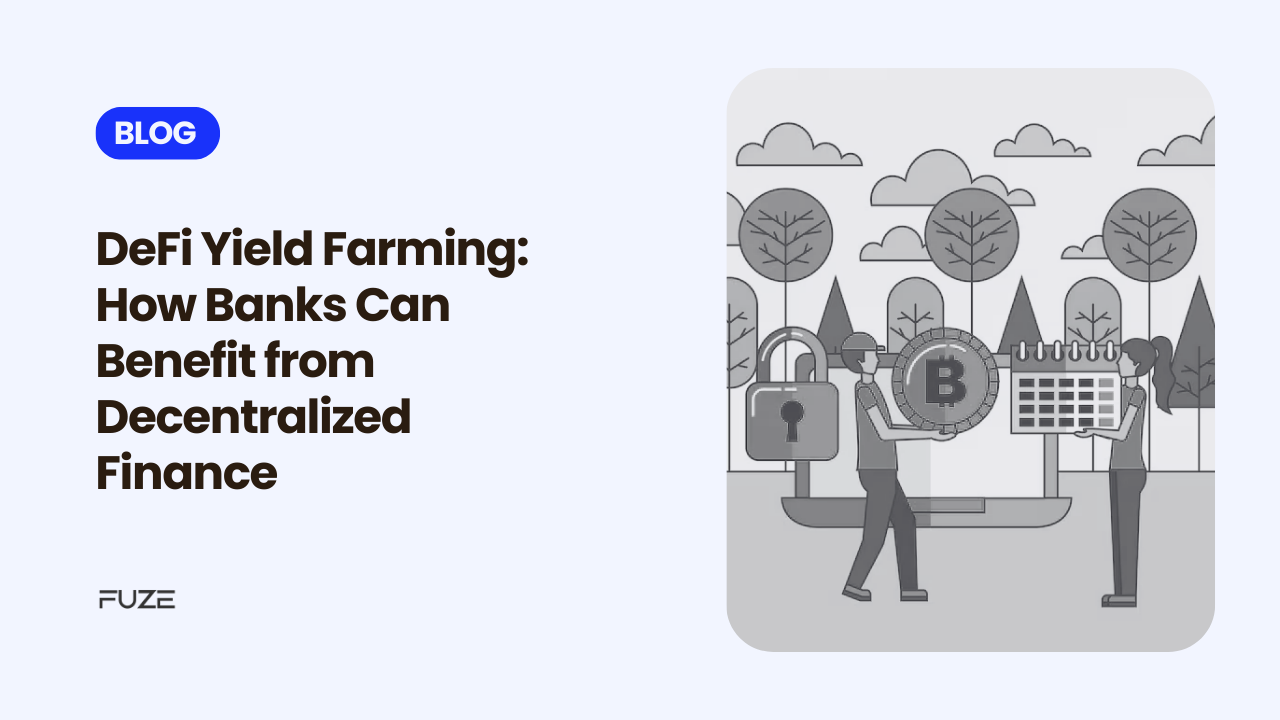DeFi is revolutionizing the financial sector with a host of opportunities far more extensive than that of the conventional banking systems. Among these elements, yield farming is considered to be a particularly powerful mechanism as it helps investors earn rewards for providing liquidity on decentralized platforms. While often credited to individual investors and crypto enthusiasts, DeFi can prove extremely beneficial for banks and financial institutions as well. In the blog below, we describe DeFi Yield farming, how it works and how integrating this into the product offerings of banks and financial institutions can bring benefits.
What is DeFi Yield Farming?
DeFi yield farming refers to the practice of providing liquidity (in the form of cryptocurrency) to decentralized finance protocols in exchange for rewards. These rewards often come in the form of interest or additional cryptocurrency tokens. Yield farming is a key component of the broader DeFi ecosystem, which operates without intermediaries like traditional banks.
Key Concepts in Yield Farming:
Liquidity pools: Liquidity pools are a collection of tokens locked in a smart contract, through which assets can be traded on decentralized exchanges (DEXs). Liquidity providers (LPs) receive a share of the transaction fees generated by the exchange in return.
Staking: Staking refers to locking up your cryptocurrency in a smart contract as a way of supporting the functioning of a blockchain network (such as validating transactions or securing the network), in return for rewards.
Annual Percentage Yield (APY): APY is a metric that measures the potential returns on an investment for yield farming. For yield farming, one can get APYs that are much higher compared to what traditional banking products offer.
DeFi Yield Farming – How Does It Work?
In yield farming, users lock their digital assets by depositing them into liquidity pools or staking protocols to provide liquidity. These liquidity pools help decentralized organizations give out financial services like lending, borrowing, and exchanging assets. In return for providing the liquidity, users receive a reward in the form of interest or native tokens on the platform.
Process of Yield Farming:
- Deposit Cryptocurrencies: Users deposit their digital assets into a liquidity pool or a staking platform.
- Earn Rewards: By doing so, users earn rewards, often paid in the form of tokens generated by the platform, which they can either reinvest or sell.
- Smart Contracts: DeFi platforms utilize smart contracts to automate the entire process, ensuring transparency and security.
While the process may seem simple, yield farming can involve risks, such as impermanent loss and smart contract exploits. However, the rewards can be significant, especially when high-yield opportunities are carefully selected.
How Banks and Financial Institutions Benefit from DeFi Yield Farming
While traditional financial institutions may feel apprehensive about venturing into the DeFi space, the advantages make yield farming an exciting proposition for banks and financial institutions seeking to evolve into better contemporary operations due to the following reasons:
- Optimal Liquid Management
For banks and financial institutions, liquidity management is a crucial part of their day-to-day operations. DeFi platforms allow financial institutions to provide liquidity to decentralized exchanges and lending platforms, where they can earn rewards. This offers them an additional revenue stream, helping to boost overall returns.
Benefits:
- Access to Higher Yields: Generally, DeFi yield farming offers higher returns compared to traditional financial instruments like bonds or saving accounts.
- Assets diversification: Banks can diversify their portfolios by allocating digital assets to liquidity pools, which can help hedge against traditional market fluctuations.
- Deepened Financial Inclusion
DeFi gives banks an opportunity to expand their scope beyond traditional customers. Through DeFi yield farming, banks are able to connect with a more extensive client base, including some who may not have access to the traditional banking systems. The decentralized nature of DeFi removes geographical barriers, enabling banks to offer financial services to unbanked or underbanked populations.
Benefits:
Global Reach: DeFi platforms are global, allowing banks to tap into new customers, especially in regions where there is limited access to traditional banking systems.
Access to Unbanked Populations: Banks can reach out to people and communities that have been excluded from the traditional financial ecosystem.
- Revenue Generation Without Intermediaries
Banks are accustomed to operating in environments where they rely on intermediaries such as clearing houses and brokers. With DeFi, banks can bypass intermediaries, directly participating in the network and maximizing their yield farming returns. This efficiency can reduce operational costs and enhance profitability.
Benefits:
No Middlemen: DeFi platforms operate without intermediaries, reducing transaction costs and increasing the efficiency of the process.
Increased Profit Margins: With reduced dependence on intermediaries, financial institutions can enhance their profit margins and simplify their operations.
- Tokenized Assets and New Investment Opportunities
Yield farming enables financial institutions to gain exposure to tokenized assets, opening new avenues for investment. Banks can engage in staking to support blockchain networks or participate in decentralized lending protocols. Moreover, as tokenized assets become more prevalent, banks can integrate these assets into their portfolios.
Benefits:
Broader Investment Horizons: Financial institutions can gain access to new asset classes that may not have been available through traditional investment channels.
New investment products: A bank can come up with innovative financial products which can tap the growing DeFi space and therefore attract more customers.
- Transparency and automation
DeFi protocols are fueled by smart contracts, which can automatically execute a transaction based on pre-determined conditions. With this, they reduce the probability of human errors and ensure transactions are carried out with full transparency.
Benefits:
Transparency: Blockchain allows for visibility in all transaction activities, an element that fosters trust and understanding between institutions and clients.
Lower Inheritance of fraud: The automation and decentralized nature of smart contracts lowers risks associated with fraudulent activities, implying a more reliable transaction ecosystem.
Key Risks and Challenges in DeFi Yield Farming
Although the benefits of DeFi yield farming are substantial, there are inherent risks that banks and financial institutions must be aware of. These include:
- Smart Contract Vulnerabilities
Smart contracts, which power DeFi platforms, can be prone to coding errors or vulnerabilities. Exploiting such vulnerabilities may accrue tremendous financial losses. Banks must assess the security of platforms they engage with and ensure that they work with well-established and audited DeFi protocols.
- Regulatory Uncertainty
The regulatory landscape for DeFi is still evolving. Banks must be aware of the potential changes in regulations and stay compliant with the laws of their jurisdictions. Interacting with DeFi protocols may expose banks to new risks that have not been fully addressed by regulators.
- Market Volatility
Crypto is a volatile market, and DeFi yield farming is no exception. The value of the assets banks invest in can fluctuate wildly, which could impact their returns. Financial institutions must assess their risk tolerance and ensure that they are taking appropriate steps to mitigate these risks.
Conclusion: Future of DeFi Yield Farming for Banks and Financial Institutions
As DeFi continues to mature, it is likely that more banks and financial institutions will look toward yield farming as a strategic tool to enhance their operations. By providing liquidity and engaging in decentralized finance, banks can unlock a wealth of new opportunities, from improving liquidity management to driving revenue growth.
However, with these opportunities come risks that must be carefully managed. Smart contract vulnerabilities, regulatory uncertainty, and market volatility are just a few of the challenges that need to be addressed for yield farming to become mainstream in the banking sector.
In the long term, DeFi yield farming has the potential to play a key role in the evolution of the financial services industry. As traditional banks embrace the benefits of decentralized finance, they can build more resilient, efficient, and transparent financial ecosystems. The future of finance is decentralized, and those who adapt early will be well-positioned to thrive in the new digital financial landscape.
Disclaimer: Virtual assets carry significant risks, including high volatility and potential loss of your entire investment. They are not backed by governmental protections, and recourse may be limited in case of loss. Always assess your risk tolerance, fully understand the risks, and seek independent financial advice if needed before investing.
Frequently Asked Questions
- Is DeFi Yield Farming secure for financial institutions?
While DeFi offers transparency and decentralization, the security of yield farming can vary by protocol. Financial institutions must conduct thorough risk assessments, smart contract audits, and ensure that the platforms they use have robust security measures in place.
- Can banks offer DeFi Yield Farming products to customers?
Yes, banks can create DeFi-based investment products or collaborate with decentralized platforms to allow customers to participate in yield farming while leveraging the security and regulatory frameworks of the traditional financial system.
- What are the risks associated with DeFi Yield Farming for financial institutions?
Risks include smart contract vulnerabilities, impermanent loss (when the value of the provided assets changes), and regulatory uncertainty. Banks need to carefully evaluate each DeFi platform’s risks before participation.
- How does DeFi Yield Farming compare to traditional banking products?
DeFi Yield Farming often offers higher returns than traditional savings accounts or fixed deposits, but it also comes with increased risks. Financial institutions can use DeFi to diversify their revenue streams while offering innovative products to their clients.
- What role does regulation play in DeFi Yield Farming for banks?
Regulation is critical for banks to ensure compliance with anti-money laundering (AML), know-your-customer (KYC), and other financial regulations. As DeFi continues to evolve, regulatory frameworks will play a key role in shaping how banks can safely participate in yield farming.







